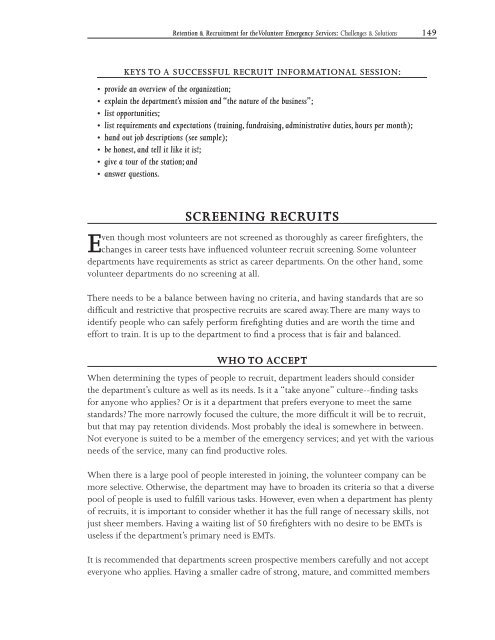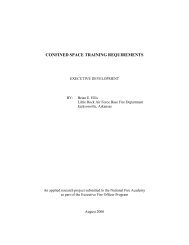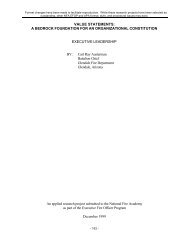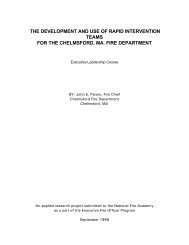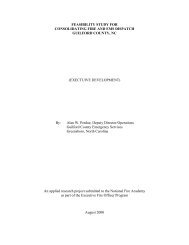Retention and Recruitment for the Volunteer Emergency Services
Retention and Recruitment for the Volunteer Emergency Services
Retention and Recruitment for the Volunteer Emergency Services
Create successful ePaper yourself
Turn your PDF publications into a flip-book with our unique Google optimized e-Paper software.
<strong>Retention</strong> & <strong>Recruitment</strong> <strong>for</strong> <strong>the</strong> <strong>Volunteer</strong> <strong>Emergency</strong> <strong>Services</strong>: Challenges & Solutions 49<br />
kEyS TO A SuCCESSFuL RECRuIT INFORMATIONAL SESSION:<br />
• provide an overview of <strong>the</strong> organization;<br />
• explain <strong>the</strong> department’s mission <strong>and</strong> “<strong>the</strong> nature of <strong>the</strong> business”;<br />
• list opportunities;<br />
• list requirements <strong>and</strong> expectations (training, fundraising, administrative duties, hours per month);<br />
• h<strong>and</strong> out job descriptions (see sample);<br />
• be honest, <strong>and</strong> tell it like it is!;<br />
• give a tour of <strong>the</strong> station; <strong>and</strong><br />
• answer questions.<br />
screening recruits<br />
Even though most volunteers are not screened as thoroughly as career firefighters, <strong>the</strong><br />
changes in career tests have influenced volunteer recruit screening. Some volunteer<br />
departments have requirements as strict as career departments. On <strong>the</strong> o<strong>the</strong>r h<strong>and</strong>, some<br />
volunteer departments do no screening at all.<br />
There needs to be a balance between having no criteria, <strong>and</strong> having st<strong>and</strong>ards that are so<br />
difficult <strong>and</strong> restrictive that prospective recruits are scared away. There are many ways to<br />
identify people who can safely per<strong>for</strong>m firefighting duties <strong>and</strong> are worth <strong>the</strong> time <strong>and</strong><br />
ef<strong>for</strong>t to train. It is up to <strong>the</strong> department to find a process that is fair <strong>and</strong> balanced.<br />
Who to accePt<br />
When determining <strong>the</strong> types of people to recruit, department leaders should consider<br />
<strong>the</strong> department’s culture as well as its needs. Is it a “take anyone” culture--finding tasks<br />
<strong>for</strong> anyone who applies? Or is it a department that prefers everyone to meet <strong>the</strong> same<br />
st<strong>and</strong>ards? The more narrowly focused <strong>the</strong> culture, <strong>the</strong> more difficult it will be to recruit,<br />
but that may pay retention dividends. Most probably <strong>the</strong> ideal is somewhere in between.<br />
Not everyone is suited to be a member of <strong>the</strong> emergency services; <strong>and</strong> yet with <strong>the</strong> various<br />
needs of <strong>the</strong> service, many can find productive roles.<br />
When <strong>the</strong>re is a large pool of people interested in joining, <strong>the</strong> volunteer company can be<br />
more selective. O<strong>the</strong>rwise, <strong>the</strong> department may have to broaden its criteria so that a diverse<br />
pool of people is used to fulfill various tasks. However, even when a department has plenty<br />
of recruits, it is important to consider whe<strong>the</strong>r it has <strong>the</strong> full range of necessary skills, not<br />
just sheer members. Having a waiting list of 50 firefighters with no desire to be EMTs is<br />
useless if <strong>the</strong> department’s primary need is EMTs.<br />
It is recommended that departments screen prospective members carefully <strong>and</strong> not accept<br />
everyone who applies. Having a smaller cadre of strong, mature, <strong>and</strong> committed members


